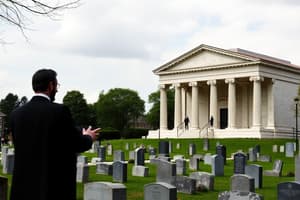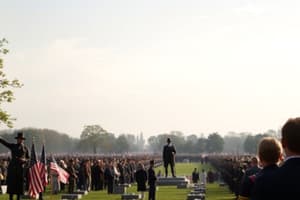Podcast
Questions and Answers
The phrase "four score and seven" is an ______ to the Declaration of Independence.
The phrase "four score and seven" is an ______ to the Declaration of Independence.
allusion
Lincoln employs ______ language by opening the speech with the phrase 'four score and seven'.
Lincoln employs ______ language by opening the speech with the phrase 'four score and seven'.
archaic
Lincoln issues a ______ toward the end of his speech, urging his audience to act to carry out the mission of the Declaration of Independence.
Lincoln issues a ______ toward the end of his speech, urging his audience to act to carry out the mission of the Declaration of Independence.
call to action
Lincoln uses ______ in his second paragraph, starting with the negative element and ending with the positive to show that some died so that others could live.
Lincoln uses ______ in his second paragraph, starting with the negative element and ending with the positive to show that some died so that others could live.
By starting with a statement his entire audience perceives to be true, Lincoln borrows the authority of that assumed truth for the rest of his speech, generating ______.
By starting with a statement his entire audience perceives to be true, Lincoln borrows the authority of that assumed truth for the rest of his speech, generating ______.
Introducing a logical argument, Lincoln uses ______ to show that the nation was dedicated to a specific proposition.
Introducing a logical argument, Lincoln uses ______ to show that the nation was dedicated to a specific proposition.
By addressing emotionally charged topics, Lincoln's second paragraph applies ______, or an appeal to emotion.
By addressing emotionally charged topics, Lincoln's second paragraph applies ______, or an appeal to emotion.
Lincoln's first paragraph applies the rhetorical quality of ______, being timely or particularly appropriate for a specific audience and place.
Lincoln's first paragraph applies the rhetorical quality of ______, being timely or particularly appropriate for a specific audience and place.
When Lincoln calls a cemetery a final resting place he is using ______.
When Lincoln calls a cemetery a final resting place he is using ______.
Lincoln uses ______ when he speaks of the nation's fathers conceiving the nation, starting an extended biological representation.
Lincoln uses ______ when he speaks of the nation's fathers conceiving the nation, starting an extended biological representation.
By repeating 'we' several times in the second paragraph, Lincoln establishes a pattern of ______.
By repeating 'we' several times in the second paragraph, Lincoln establishes a pattern of ______.
In a time of civil war, Lincoln's repetition of 'we' emphasizes and creates shared national ______.
In a time of civil war, Lincoln's repetition of 'we' emphasizes and creates shared national ______.
The first portion of Lincoln's speech praises the dead, also known as ______.
The first portion of Lincoln's speech praises the dead, also known as ______.
The second portion of Lincoln's speech gives advice to the living, otherwise known as the ______
The second portion of Lincoln's speech gives advice to the living, otherwise known as the ______
The 'new birth of freedom' creates structural ______, blending imagistic unity with conceptual unity.
The 'new birth of freedom' creates structural ______, blending imagistic unity with conceptual unity.
The goal of Lincoln's call to action is to transform anyone who hears and agrees with his words into a larger generation of the nation's ______.
The goal of Lincoln's call to action is to transform anyone who hears and agrees with his words into a larger generation of the nation's ______.
Locating his speech in a specific place and time, Lincoln draws persuasive power from that particular ______.
Locating his speech in a specific place and time, Lincoln draws persuasive power from that particular ______.
Lincoln organizes his speech using the structure of the ______ funeral oration.
Lincoln organizes his speech using the structure of the ______ funeral oration.
Lincoln opens his speech with an allusion to the Declaration and closes it with an allusion to the ______.
Lincoln opens his speech with an allusion to the Declaration and closes it with an allusion to the ______.
He also opens with an allusion to the ______ and refers explicitly to God in his final sentence.
He also opens with an allusion to the ______ and refers explicitly to God in his final sentence.
Flashcards
Allusion
Allusion
A reference to another work, idea, or event.
Archaic Language
Archaic Language
Language that is old-fashioned or outdated.
Call to Action
Call to Action
An appeal to an audience to take action.
Ethos
Ethos
Signup and view all the flashcards
Logos
Logos
Signup and view all the flashcards
Pathos
Pathos
Signup and view all the flashcards
Kairos
Kairos
Signup and view all the flashcards
Euphemism
Euphemism
Signup and view all the flashcards
Metaphor
Metaphor
Signup and view all the flashcards
Anaphora
Anaphora
Signup and view all the flashcards
Greek Funeral Oration
Greek Funeral Oration
Signup and view all the flashcards
Contrast
Contrast
Signup and view all the flashcards
Study Notes
- The speech alludes to the Declaration of Independence with the phrase "four score and seven", referencing the line "that all men are created equal".
- It opens with an allusion to the Declaration and closes with an allusion to the Constitution.
- The speech opens with an allusion to the Bible and makes a specific mention of God in the final sentence.
Archaic Language
- The speech begins with the archaic phrase "four score and seven".
- The use of archaic language signals a departure from everyday conversation, lending the speech a special and elevated tone.
Call to Action
- A call to action is issued toward the end of the speech, urging the audience to act.
- The suggested action is to carry out the mission of the Declaration of Independence.
- The phrase "new birth of freedom" creates structural unity, blending imagistic and conceptual unity.
- Anyone who agrees with the speech becomes part of a larger generation of the nation's founders.
Contrast
- Contrast is used in the second paragraph, moving from negative to positive: some died so that others, and the entire nation, could live.
Classical Rhetorical Authority
- Classical rhetoric identifies three sources of rhetorical authority: ethos, logos, and pathos.
- The speech generates ethos by starting with a universally accepted truth.
- A logical argument (logos) is introduced in the first paragraph: the idea that the nation was dedicated to a specific proposition.
- The second paragraph applies pathos, appealing to emotion.
Kairos
- The first paragraph applies kairos, making it timely and appropriate for the audience and place.
- The speech draws persuasive power by situating itself in a specific place and time.
Euphemism
- A euphemism is used in the second paragraph, referring to a cemetery as a "final resting place".
- In reality, the battlefield was a scene of carnage after the Battle of Gettysburg.
Metaphor
- The speech introduces a metaphor by referring to the nation's fathers conceiving the nation, an extended biological metaphor of conception and birth that continues throughout the speech.
Repetition
- The speech employs anaphora with the repetition of "we" in the second paragraph.
- This repetition establishes and emphasizes shared national unity during a time of civil war.
Speech Structure: Greek Funeral Oration
- It follows the classical rhetorical structure of the Greek funeral oration.
- The first part praises the dead (epainesis), and the second part advises the living (parainesis).
Studying That Suits You
Use AI to generate personalized quizzes and flashcards to suit your learning preferences.




